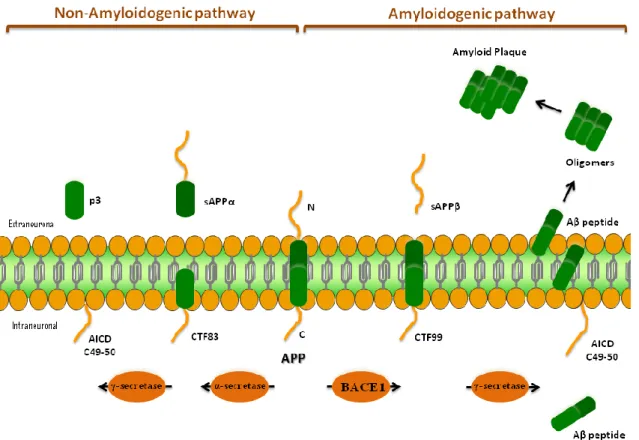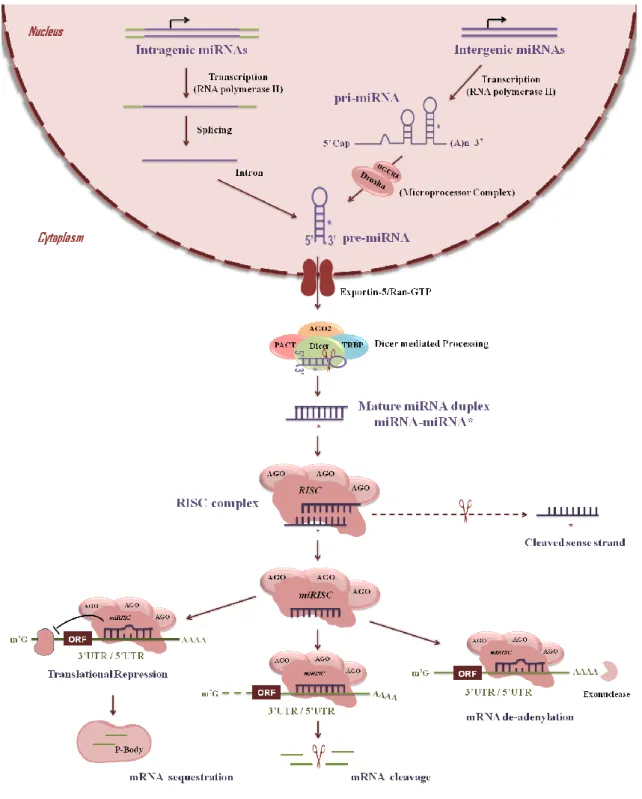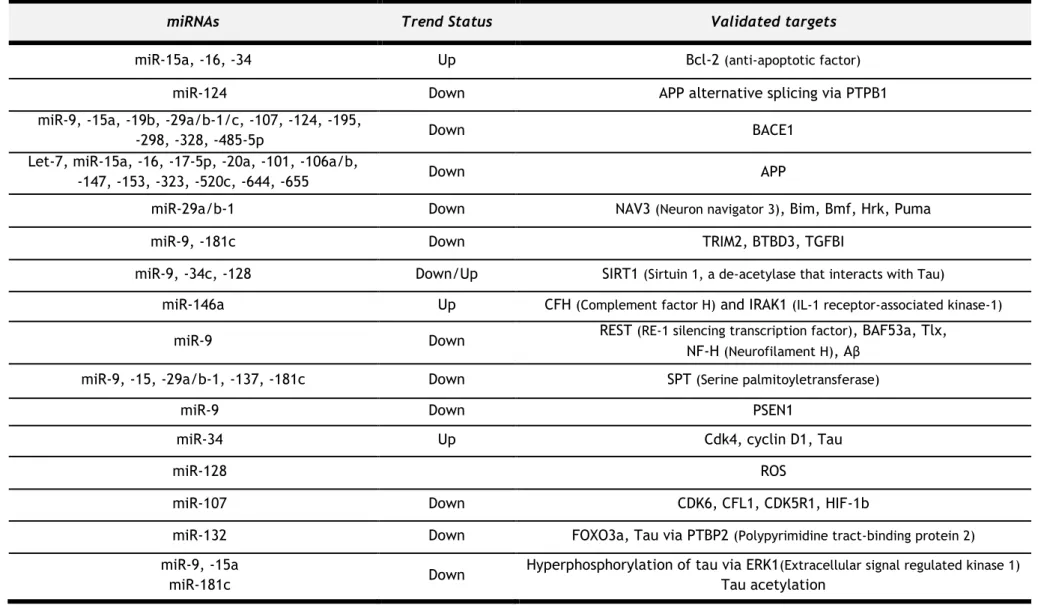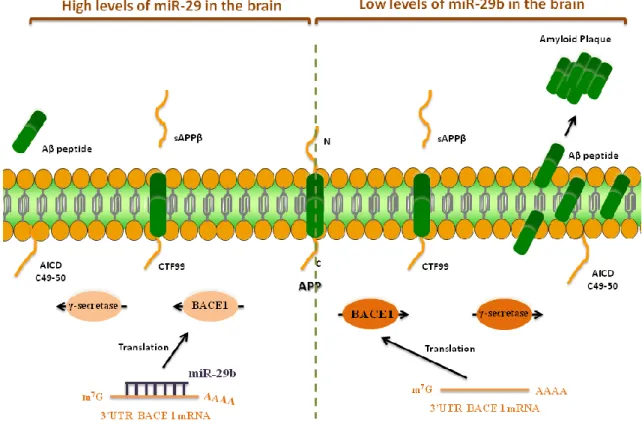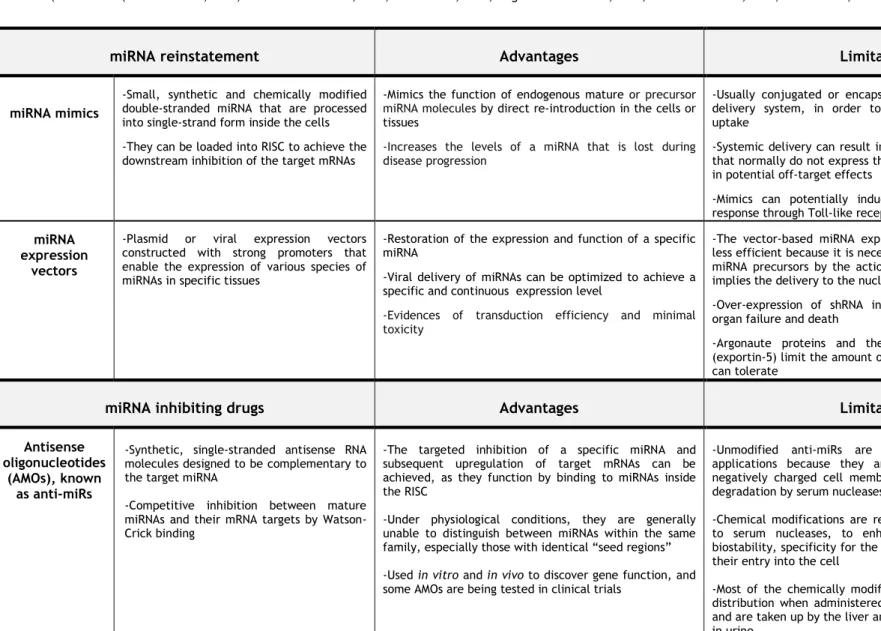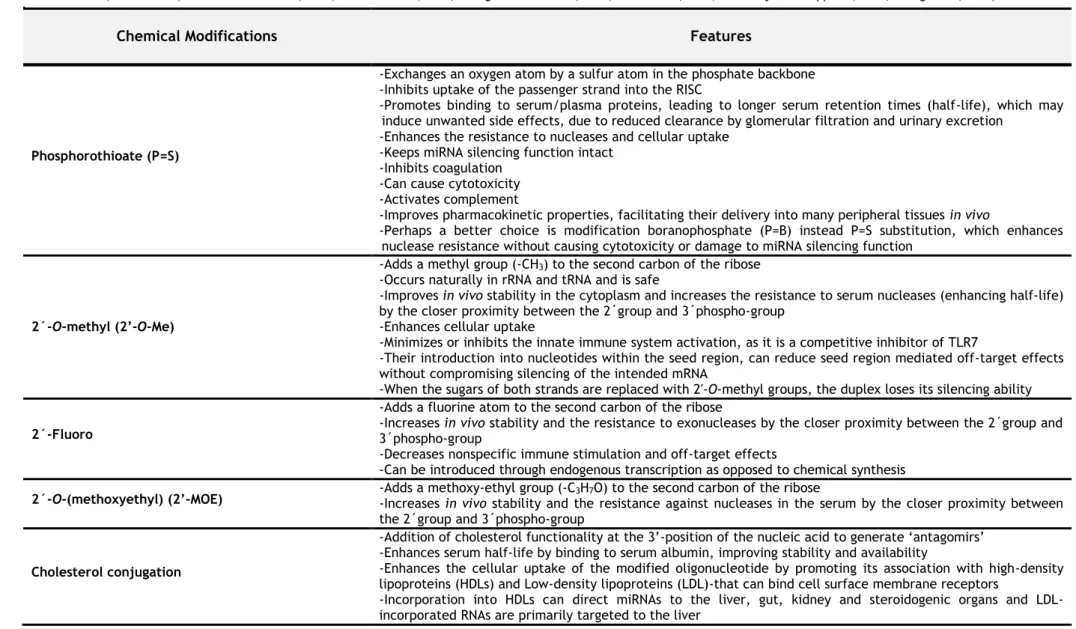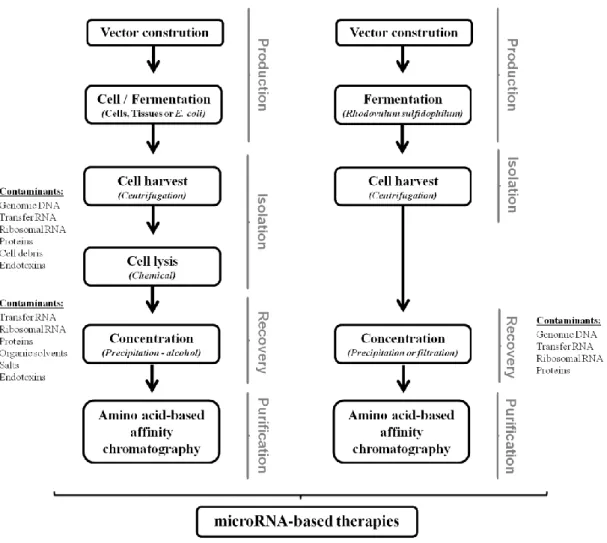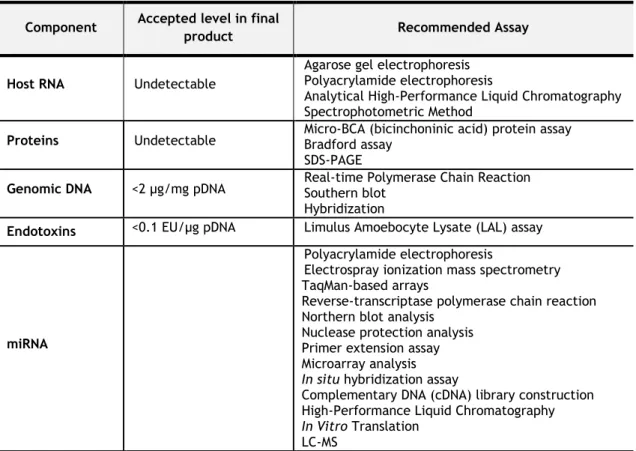UNIVERSIDADE DA BEIRA INTERIOR
Ciências
miRNA-29 bioseparation and target delivery
strategies for Alzheimer’s disease
Patrícia Alexandra Nunes Pereira
Tese para obtenção do Grau de Doutor em
Bioquímica
(3º ciclo de estudos)
Orientadora: Prof.ª Doutora Fani Pereira de Sousa
Co-orientador(a): Prof.ª Doutora Ana Rita Figueiras
Prof. Doutor Ilídio Correia
"Whether or not your efforts are smiled upon by fate,
what really matters in the end is to be able to say,
I did what I was able to"
Louis Pasteur
Aos meus Pais…
Por todo o amor, apoio incondicional e compreensão
Amo-vos
This work was financed by the Portuguese Foundation for Science and Technology
(SFRH/BD/81914/2011) under the program QREN - POPH - Type 4.1 – Advanced
Training, cofounded by the European Social Fund and by national funds from the
MCTES. Moreover, this work was also supported in the framework of research and
development projects (PTDC/EBB-BIO/114320/2009 and EXPL/BBB-BIO/1056/2012)
and strategic programs (Pest-C/SAU/UI0709/2011 and Pest-OE/SAU/UI0709/2014)
co-founded by the operational program factors of competitiveness – COMPETE
(FCOMP-01-0124-FEDER-041068 – EXPL/QEQ-MED/1068/2013) and co-founded by FEDER funds
(FCOMP-01-0124-FEDER-027560) of COMPETE.
Acknowledgments
First and foremost, I would like to express my sincere gratitude to my supervisors Professor Fani Sousa, Professor Ana Rita Figueiras and Professor Ilídio Correia, for all the careful guidance, valuable advice and trust. To Professor Fani Sousa my deepest appreciation for her valuable scientific knowledge and experiences shared during the last years. I would like to thanks for encouraging my research and for allowing me to grow as a research scientist. In addition, I am also grateful for believing in me, for her availability, dedication, help, motivation, unconditional support in difficult times, by the endless hours of conversation and especially for her friendship and patience, my very thanks to my " scientific mother "! To my co-supervisor Professor Ana Rita Figueiras my sincerely appreciation for her invaluable support, for the continuous guidance, help, availability, dedication, for all encouragement and especially for her friendship. It was a huge privilege working with you.
I would like to express my sincere gratitude to Professor João Queiroz for all the vast and valuable scientific knowledge that he transmitted me. I am really thankful for the availability, dedication and interest that he demonstrated for my work through the constructive scientific discussions and suggestions made during the development of the same, which were crucial for their success.
I would like to thanks to Professor Carla Cruz for her friendship, availability, help, support and interest demonstrated for my work through the scientific expertise provided, as well as for the trust in me through participation in her scientific projects. I would also like to thanks to Professor Cláudio Maia for the scientific expertise and valuable contribution throughout this thesis. To Professor Luís Passarinha, for his friendship, motivation, help and support, between a coffee and a laugh.
I’m deeply grateful to Fundação para a Ciência e Tecnologia (FCT) for the financial support through my PhD fellowship (SFRH/BD/81914/2011).
I also thank to all the people involved in Health Sciences Research Centre of the University of Beira Interior (CICS-UBI), especially to the Biotechnology and Biomolecular Sciences research group which cooperated in the development of this work. A special acknowledgment to the laboratory technicians Margarida Carrilho and Sofia Duarte that really cooperated for the successful development of this work and, especially for all the friendliness, availability, helpfulness and excellent moments of good humor.
To all my laboratory colleagues, specially Ângela Sousa, Eduarda Coutinho, Rita Martins, Margarida Almeida, Rita Videira, Helena Marcelino, Ana Martinho, Susana Ferreira and Filomena Silva, I would like to acknowledge all these people by their teachings, valuable
technical help, feedback, unspeakable patience, friendship, advice, support on the not so good times and willingness that contributed for this work to move forward. Thanks for all the great moments. Moreover, I am extremely thankful to Joana Tomás, who with her special expertise provided me with invaluable advice and encouragement. Your patience, support, friendship and collaboration were crucial for the success of this work, I sincerely thank you. A very special thanks to Augusto Pedro, companion and friend, who supported me in good times and bad times, by their critical thinking that contributed significantly to the quality of this work, as well as, by your availability and help whenever I needed. For all your love, affection and friendship, and all the confidence placed in me, by the patience, advices and motivation throughout all the days of intensive work. We managed to overcome more this stage of our lives together, thank you my love.
Por último, e não menos importante, gostaria de agradecer de uma forma muito especial à minha família, por todo o amor, confiança e apoio nos tempos mais difíceis durante a minha formação acadêmica. Aos meus pais, por tornarem isto possível, por toda a vossa bondade e paciência, por me apoiarem sempre sem nunca duvidar e por entenderem as minhas inúmeras ausências. Estou-vos eternamente grata. Esta tese tem o vosso apoio incondicional, amor e carinho. Amo-vos.
Resumo Alargado
A recente descoberta da tecnologia do RNA de interferência tornou-se numa nova ferramenta que permite regular seletivamente o padrão de expressão de um ou mais genes, o que pode ser explorado no âmbito de aplicação terapêutica. Deste modo, os resultados promissores desta nova abordagem têm vindo a reforçar a investigação relacionada com o RNA, avaliando e compreendendo os mecanismos celulares em que está envolvido, com o objetivo de o usar como uma nova classe de produtos bioterapêuticos, de fácil translação e implementação para o âmbito clínico. Na verdade, o mecanismo celular responsável pelo silenciamento da expressão génica apresenta um enorme potencial terapêutico que poderá alterar os tratamentos atualmente disponíveis para diversas patologias, como por exemplo as doenças neurológicas.
Os microRNAs (miRNAs) constituem uma classe de RNAs de baixo peso molecular e, nos últimos anos, têm sido cada vez mais reconhecidos como moléculas endógenas reguladoras em numerosos processos biológicos. Devido à sua especificidade e eficiência, os miRNAs tornaram-se uma das ferramentas mais utilizadas no silenciamento de genes pelo mecanismo de RNA de interferência, uma vez que podem bloquear a síntese de proteínas através da indução da degradação do RNA mensageiro. Assim, os miRNAs podem ser considerados agentes terapêuticos promissores.
Durante a última década, a hipótese de que os miRNAs podem ser usados como biofármacos para regular e controlar várias vias envolvidas no desenvolvimento e progressão da doença de Alzheimer (DA) ganhou consistência, uma vez que estes apresentam um papel crucial em muitas funções neuronais, tais como diferenciação, plasticidade sináptica, formação da memória, e normalmente estão sub-expressos em doentes com esta patologia. A doença de Alzheimer é a forma mais comum de demência e caracteriza-se por uma perda neuronal e sináptica generalizada, que causa um declínio progressivo e irreversível em diversas funções cognitivas. Embora, as causas ainda não sejam completamente compreendidas, sabe-se que esta doença neurodegenerativa está associada ao aparecimento de dois tipos de agregados proteicos, nomeadamente placas extracelulares beta-amiloides (Aβ) e complexos neurofibrilares intraneuronais.
A formação das placas de Aβ resulta da clivagem sequencial da proteína percursora amiloide (APP) pela BACE1 e, posteriormente, pelo complexo gama-secretase dando origem às espécies Aβ tóxicas. Alguns estudos têm descrito uma relação causal entre a expressão do miR-29 e a DA, uma vez que a diminuição dos níveis de expressão da família miR-29 tem sido associada ao aumento da expressão da BACE1 e, consequentemente da formação dos péptidos Aβ em doentes com DA. Desta forma, a utilização do miR-29 pode proporcionar uma estratégia terapêutica eficaz na prevenção, controlo da progressão e tratamento desta patologia.
As terapêuticas baseadas no uso de miRNAs recorrem, na sua maioria, à utilização de miRNAs sintéticos. Embora a síntese de miRNAs possa ser muito eficiente, verifica-se normalmente a presença de contaminantes nas amostras de RNA sintetizado o pode levar à inespecificidade do silenciamento génico. Além disso, por norma, no processo de preparação do RNA sintético é necessário recorrer à utilização de solventes tóxicos, solventes orgânicos e condições desnaturantes, que podem comprometer a qualidade e integridade do produto alvo. Por todos estes motivos, e considerando o objetivo de aplicação terapêutica destes novos produtos biofarmacêuticos, torna-se evidente a necessidade de desenvolver novos processos eficientes ou melhorar as metodologias atualmente empregues para a sua preparação. Assim, um dos desafios mais importantes no desenvolvimento destas estratégias terapêuticas surge com a necessidade de produzir miRNA com elevado grau de pureza e atividade biológica, de modo a satisfazer os requisitos necessários à sua aplicação. Deste modo, uma das estratégias que pode ser aplicada consiste na produção recombinante de biomoléculas utilizando hospedeiros procarióticos.
Desta forma, o objetivo principal do presente trabalho consiste no desenvolvimento e implementação de uma plataforma biotecnológica para a produção e purificação de precursores de miRNAs, em particular o pre-miR-29b (percursor do miR-29), cuja aplicação visa o silenciamento seletivo de vias endógenas diretamente relacionados com DA, nomeadamente a BACE1 e os péptidos Aβ. Paralelamente, serão desenvolvidas e caracterizadas nanopartículas poliméricas para a entrega do pre-miR-29b no citoplasma de células neuronais de forma seletiva e eficaz, de modo a assegurar o sucesso destas administrações.
O sistema de expressão recombinante utilizado permitirá, pela primeira vez, a produção e o isolamento do pre-miR-29b humano na bactéria Rhodovulum sulfidophilum (R. sulfidophilum) DSM 1374, mantendo a sua atividade biológica. A utilização deste hospedeiro bacteriano é inovadora e vantajosa, devido à sua capacidade invulgar de secretar os ácidos nucleicos para o meio de cultura, bem como devido à ausência de ribonucleases no mesmo, permitindo a obtenção do miRNA de interesse com baixo conteúdo de impurezas bacterianas. A fim de otimizar a produção e acumulação de miRNAs no espaço extracelular, as condições de crescimento foram estudadas, nomeadamente no que diz respeito ao efeito da temperatura e concentração de cloreto de sódio. Os ensaios realizados demonstraram ser possível desenvolver um protocolo para o crescimento aeróbio da bactéria R. sulfidophilum, na ausência de luz, a 30ºC, o que resulta num melhoramento do crescimento das células, seguido de um aumento da produção do pre-miR-29b humano. Neste trabalho foi possível atingir uma concentração de pre-miR-29b no meio extracelular de aproximadamente 182 µg/L, após 40 horas de crescimento bacteriano e uma concentração de 358 µg/L de pre-miR-29b intracelular, após 32 horas de fermentação.
Para que seja possível a aplicação terapêutica do pre-miR-29b é necessário ter em conta as exigências estabelecidas pelas agências reguladoras internacionais, que requerem a produção de miRNA com elevada qualidade e atividade biológica. Para assegurar esta condição, foram desenvolvidas novas estratégias de purificação para o pre-miR-29b, baseadas em cromatografia de afinidade. A fim de alcançar a máxima seletividade e especificidade na separação do pre-miRNA de outras biomoléculas do hospedeiro (outras espécies de RNA e proteínas), foram desenvolvidos suportes de afinidade baseados nas interações biológicas que são estabelecidas a nível celular, usando como ligandos de afinidade, aminoácidos básicos como a L-lisina e a L-arginina. Na estratégia de purificação com o aminoácido de L-lisina foi demonstrada pela primeira vez a purificação de pre-miRNA utilizando um gradiente decrescente de concentração de sulfato de amónio em três passos, o que permitiu explorar maioritariamente interações hidrofóbicas. Contudo, a necessidade de aplicar elevadas concentrações de sal pode ser visto como uma desvantagem devido aos custos e ao impacto ambiental associado ao processo, principalmente no que diz respeito à aplicação ao nível industrial. De modo a ultrapassar estas limitações foi usada L-arginina como aminoácido imobilizado. Este estudo demonstrou a possibilidade de purificar o pre-miR-29b utilizando três estratégias diferentes de eluição, nomeadamente concentrações decrescentes de sulfato de amónio e duas condições de eluição moderadas, tais como usando um gradiente crescente de cloreto de sódio e a adição de um agente de competição (arginina) ao tampão de eluição. A versatilidade da matriz de arginina na purificação do pre-miR-29b sugeriu que o mecanismo de interação envolveria uma multiplicidade de interações não-covalentes, que globalmente resultam no bioreconhecimento do RNA de interesse. O reconhecimento bioespecífico e seletivo do pre-miR-29b por estes suportes cromatográficos permitiu a sua purificação e recuperação de forma eficiente, com elevados rendimentos, grau de pureza e integridade, a partir de uma mistura complexa. Além disso, a utilização da cromatografia de afinidade com arginina resultou na eliminação das impurezas associadas à produção recombinante, nomeadamente proteínas e endotoxinas, respeitando os critérios estabelecidos pelas agências reguladoras (por exemplo “Food and Drug Administration” – FDA). Considerando que esta estratégia cromatográfica requer condições suaves de eluição, torna-se um método de purificação mais económico do que a lisina-agarose.
Em paralelo, a ligação do pre-miR-29b aos aminoácidos em estudo foi avaliada por biosensor. Este estudo também permitiu compreender as interações envolvidas entre o pre-miR-29b e as matrizes de lisina- e arginina-agarose, assim como determinar as melhores condições que favorecem o bioreconhecimento e a especificidade de ligação dos aminoácidos ao pre-miR-29b, preservando a sua estabilidade e integridade. Os resultados obtidos neste estudo mostraram a existência de várias interações entre o pre-miR-29b e as matrizes de afinidade com os aminoácidos imobilizados, tais como interações hidrofóbicas, eletrostáticas, catião-π, pontes de hidrogénio e forças de “van der Waals”.
Tendo em conta que a estrutura dos suportes cromatográficos está em contínuo desenvolvimento de modo a proporcionar separações rápidas e eficientes, nomeadamente para a purificação de ácidos nucleicos, foi também testado um suporte monolítico na purificação do pre-miR-29b. Esta estratégia que associa a alta capacidade destes suportes com a especificidade e seletividade conferida pelo ligando de agmatina (um derivado da L -arginina), permitiu a recuperação do pre-miR-29b com alta eficiência (95%) e com elevado grau de pureza (90%) para posterior aplicação nos ensaios in vitro. Além disso, este suporte monolítico revelou elevada capacidade de ligação para o RNA, permitindo uma rápida e eficiente separação do pre-miR-29b, independentemente da taxa de fluxo aplicada. No geral, foi possível desenvolver métodos de purificação simples, robustos, versáteis e de elevada reprodutibilidade, que permitiram minimizar o manuseamento das amostras e evitar o uso de condições desnaturantes e solventes orgânicos, contribuindo para o sucesso das aplicações terapêuticas do RNA.
No entanto, o sucesso das terapêuticas baseadas em miRNAs depende também da capacidade de entrega do miRNA, de forma seletiva e eficiente, aos órgãos-alvo, com a mínima toxicidade. De facto, a entrega cerebral de fármacos é limitada por diversos fatores intrínsecos, nomeadamente a sua rápida degradação quando em contato com os fluidos corporais e a reduzida permeabilidade ao longo da barreira hematoencefálica (BHE). Para ultrapassar estas limitações, vários sistemas de entrega de fármacos não-virais têm sido desenvolvidos e caracterizados, nomeadamente os sistemas poliméricos (poliplexos) que possuem características intrínsecas ideais para a transfecção, proteção e libertação controlada e direcionada de RNA. No presente trabalho, as formulações foram preparadas com polímeros comerciais, tais como quitosano e polietilenimina e demonstraram elevada capacidade de transporte de RNA, apresentando pequenas dimensões e uma forte carga superficial positiva. Além disso, e considerando o campo de aplicação do presente trabalho, estes sistemas devem também ter a capacidade de penetrar a BHE, levando a um aumento da concentração do pre-miRNA no cérebro e, consequentemente uma melhoria da sua ação terapêutica. Deste modo, a fim de potenciar o efeito terapêutico das abordagens baseadas no RNAi no sistema nervoso central, os poliplexos desenvolvidos foram funcionalizados com ligandos específicos, tais como a lactoferrina e o ácido esteárico, os quais são reconhecidos pelos recetores localizados à superfície da BHE. Este estudo revelou que os sistemas de entrega desenvolvidos conseguem penetrar a BHE e assim entregar o pre-miR-29b no cérebro. Finalmente, avaliou-se a atividade biológica do pre-miR-29b recombinante através da verificação da sua eficiência na regulação dos níveis de expressão dos genes relacionados com a DA, em particular no silenciamento da BACE1 humana, utilizando modelos in vitro (linhas de células neuronais). O efeito da administração do pre-miR-29b recombinante foi verificado tanto ao nível da expressão do RNA mensageiro como ao nível da expressão da proteína BACE1, através de RT-qPCR, Western blot e Imunocitoquímica. Os resultados sugerem que o
pre-miR-29b recombinante pode funcionar como biofármaco para a modulação terapêutica dos níveis de BACE1, uma vez que foram atingidos elevados níveis de inibição, ou seja 80% de redução para a expressão da proteína BACE1 e 45% para os níveis dos péptidos beta amiloides, quando comparados com as células não transfectadas e células transfectadas como um RNA não relacionado bem como um miR-29b sintético.
Em suma, a implementação destas metodologias terá um grande impacto na indústria farmacêutica e biotecnológica, fornecendo a base para a utilização de novas formas terapêuticas baseadas na utilização de miRNAs, não apenas para aplicação em doenças neurológicas, mas também para futuros alvos terapêuticos que possam ser de interesse.
Palavras-chave
Doença de Alzheimer; Cromatografia de Afinidade; Direcionamento ao cérebro; Silenciamento Génico; Pre-miR-29b humano; Produção Recombinante; Eficiência de Transfecção; Poliplexos
Abstract
The possibility of selectively alter the expression pattern of a particular gene has been sought by scientists and clinicians for a long time. Nowadays, RNA interference (RNAi)-based technology has become a novel tool for silencing gene expression in cells. In addition, this strategy encloses an enormous therapeutic potential that could change the course of the currently applied treatments in several life threatening pathologies and it is expected that this technology can be translated onto clinical applications in a near future. MicroRNA (miRNA) has become a commonly employed tool for gene silencing, since it prevents protein synthesis by inducing the messenger RNA (mRNA) degradation, with a high specificity degree. Consequently, in the last years, the miRNAs have emerged as biopharmaceuticals to regulate several pathways involved in the insurgence and progression of the Alzheimer’s disease (AD), since they might have key regulatory roles in many neuronal functions, such as differentiation, synaptic plasticity and memory formation, and typically they are down-regulated in disease conditions. In the literature there are some studies describing a causal relationship between miR-29 expression and AD, since a loss of miR-29 cluster can contribute to increased beta-amyloid precursor protein-converting enzyme 1 (BACE1) and Amyloid-β (Aβ) levels in sporadic AD patients. Thus, this evidence supports the possibility to use miR-29 as a potential therapeutic target for AD therapy.
In general, miRNA-based therapy relies on the use of synthetic microRNAs. However, these synthesized formulations typically present contaminants that can lead to non-targeted gene silencing, which still restricts the pre-clinical or clinical application of these RNAs. Thus, considering this therapeutic purpose and the global distribution of novel biopharmaceuticals it is necessary to develop efficient processes for their preparation. The development of new strategies for microRNA production with high purity degree and biologically active is extremely required. One of the strategies might be the use of the recombinant production of biomolecules using prokaryotic hosts.
Hence, the present work intends to develop and establish an integrative biotechnological platform to biosynthesize and purify a recombinant miRNA precursor (pre-miR-29b) to act in the selective silencing of endogenous pathways directly related with AD, in particular BACE1 and Aβ. In addition, the success of these therapies also depends upon the ability to selectively and efficiently deliver the pre-miR-29b in the cytoplasmic compartment of neuronal cells, the location where their function is exerted; therefore the development of miRNA delivery systems was also envisioned.
The expression system Rhodovulum sulfidophilum (R. sulfidophilum) DSM 1374 allowed, for the first time, the production of human pre-miR-29b with a straightforward recuperation of
pre-miR-29b in a single step, maintaining its biological active form. The application of this recombinant bacterial microorganism is innovative and is supported by the unusual capacity of secreting the nucleic acids to the extracellular space and the absence of host ribonucleases in the culture medium. Therefore, it is expected that the secreted miRNA will be devoid of main bacterial associated impurities. Regarding the growth conditions, and conversely to what was previously described for this bacterium, our results showed to be possible to develop an original approach for the aerobic growth of the R. sulfidophilum, which results in a cell growth improvement followed by an enhanced production of human pre-miR-29b. The extracellular pre-miR-29b concentration was approximately 182 µg/L, after 40 hours of bacterial growth and the total intracellular pre-miR-29b was of about 358 μg/L, at 32 hours of cell growth.
To further develop a potential therapeutic application, the major interest is not only to produce high quantities of RNA but also to obtain and preserve its biological active form, fulfilling the requirements of regulatory agencies. Hence, to assure that this prerequisite is met it was used a novel and effective purification strategy, based on affinity chromatography, to purify the pre-miR-29b. Therefore, in order to achieve the selectivity towards the target pre-miRNA and the maximum resolution between the pre-miR-29b and other host biomolecules (transfer RNAs and proteins) it was used an affinity support that exploits the same biological interactions that are established within the cell, by using immobilized amino acids (L-lysine and L-arginine), as specific ligands. The recognition of the pre-miR-29b achieved with these supports, allowed its selective recovery from a complex mixture with high efficiency and high purity. In parallel, the binding of pre-miRNA to these different amino acids was studied by Surface Plasmon Resonance. This information brings important insights concerning the characterization of the pre-miRNA binding onto chromatographic supports. Moreover, it was possible to determine some particular conditions enabling the improvement of the binding specificity of the amino acid ligands used to purify miRNA, preserving the RNA integrity. Taking into account that the structure of the chromatographic supports has been continuously developed to afford rapid and efficient separations, namely for the purification of nucleic acids, it was also tested a monolithic support to purify the pre-miR-29b. The association of the high capacity of these supports with the specificity conferred by the agmatine ligand (a derivative of L-arginine) represented a novelty and an advantage to obtain highly pure pre-miR-29b (90%) with a high recovery yield (95%).
The establishment of an effective application of miRNAs is usually constrained by different phenomena, namely their easy degradation when in contact with the body fluids. To overcome this limitation, delivery systems, such as polymeric systems (polyplexes), were developed and characterized in order to encapsulate and protect the pre-miR-29b biopharmaceuticals from degradation, allowing their sustained and targeted release. The formulations prepared with chitosan and polyethylenimine demonstrated high loading
capacity, small sizes and exhibited a strong positive charge on their surface. In addition, considering the application field of this work, the delivery systems should also have the ability to penetrate the Blood-Brain Barrier (BBB), causing an increase of the pre-miRNAs concentration in the brain and, consequently the improvement of the therapeutic effect. Actually, BBB is an intrinsic barrier limiting miRNA therapeutic effect on the central nervous system. Thus, to improve the delivery of pre-miRNA therapeutics in the brain, the polyplexes were functionalized with specific ligands, namely lactoferrin and stearic acid which are recognized by cell surface receptors of BBB.
Finally, it was evaluated the biological activity of the recombinant pre-miR-29b by measuring the efficiency on human BACE1 knockdown, using in vitro neuronal cell lines. The effect of recombinant pre-miR-29b administration was verified by both assessing the mRNA and protein human BACE1 levels, by using RT-qPCR, Western blot and Imunocytochemistry. Results suggest that recombinant pre-miR-29b can represent a novel biopharmaceutical product for the therapeutic modulation of human BACE1 levels, because high levels of inhibition were achieved, namely 80% of reduction for BACE1 protein expression and 45% for Aβ42 levels. Globally, the implementation of these cutting-edge technologies can have a great impact on the biopharmaceutical industry, providing the basis for the implementation of novel miRNA-based therapeutics, not only for neurological disorders but also for future therapeutic targets that can be of potential interest.
Keywords
Affinity Chromatography; Alzheimer’s disease; Brain-targeting; Gene silencing; Human pre-miR-29b; Recombinant Production; Transfection Efficiency; Polyplexes
Thesis Overview
This thesis is structured in four main chapters. The first chapter is divided into three sections. The first section of chapter 1 provides a brief explanation concerning the importance and interest to apply microRNAs as biopharmaceuticals, in order to regulate endogenous pathways involved in the emergence and progression of the Alzheimer’s disease. This section presents a general introduction to the main issues detailed in sections 2 and 3. The second section consists in a succinct literature review about the relevance of developing and establishing new and integrative approaches to biosynthesize, isolate, purify and deliver the pre-miRNAs molecules, also discussing the main challenges and future directions for the development of miRNA-based therapies for neurodegenerative diseases (Paper I. Current progress on microRNAs-based therapeutics). Lastly, the third section discusses the main issues related with non-coding RNAs purification, the advantages and limitations associated to the current chromatographic methods, as well as the improvements that have been done lately, in order to obtain pure and biologically active samples. This third section is also presented in a paper review form (Paper II. Affinity approaches in RNAi-based therapeutics purification). The second chapter includes the main, as well as, the specific goals established for the development of the present research project.
Afterwards, the third chapter consists in the presentation and discussion of the results obtained during this research work, in the form of original research papers organized as follows:
Paper III. Advances in time-course extracellular production of human pre-miR-29b from Rhodovulum sulfidophilum
Paper IV. Analysis of pre-miR-29b binding conditions to amino acids by Surface Plasmon Resonance Biosensor
Paper V. New approach for purification of pre-miR-29 using lysine-affinity chromatography Paper VI. Purification of pre-miR-29 by arginine-affinity chromatography
Paper VII. Pharmaceutical-grade pre-miR-29 purification using an agmatine monolithic support Paper VIII. Characterization of polyplexes involving small RNA
Paper X. Brain-targeting study of lactoferrin-stearic acid–Chitosan/Polyethylenimine pre-miR-29b-delivery system
To finish, the fourth chapter summarizes the concluding remarks obtained during this research work, regarding the development and implementation of cutting-edge technologies to the production, bioseparation and delivery of pre-miRNAs. The impact of the findings here reported on biopharmaceutical industry will also be addressed, discussing the application of these novel approaches based on microRNAs, not only for neurological disorders but also for future therapeutic targets that can be of potential interest. In addition, the future trends of this thesis and additional research work will be also suggested to complement the important findings achieved with this project.
Table of Contents
List of Figures xxvii
List of Tables xxix
List of Abbreviations xxxi
List of Scientific Publications xxxiii
List of Scientific Communications xxxv
Chapter 1
1. Alzheimer’s disease and microRNAs 3
1.1. Introduction 3
1.2. Alzheimer’s disease 4
1.3. MicroRNAs as therapeutic products 11
1.4. miR-29 in Alzheimer’s disease 15
1.5. References 19
2. Current progress on microRNAs-based therapeutics (Paper I) 25 3. Affinity approaches in RNAi-based therapeutics purification (Paper II) 65 Chapter 2
Aims of the thesis 101
Chapter 3
Paper III. Advances in time-course extracellular production of human
pre-miR-29b from Rhodovulum sulfidophilum 107
Paper IV. Analysis of pre-miR-29b binding conditions to amino acids by Surface
Plasmon Resonance Biosensor 135
Paper V. New approach for purification of pre-miR-29 using lysine-affinity
chromatography 159
Paper VI. Purification of pre-miR-29 by arginine-affinity chromatography 165 Paper VII. Pharmaceutical-grade pre-miR-29 purification using an agmatine
monolithic support 175
Paper VIII. Characterization of polyplexes involving small RNA 187 Paper IX. Recombinant pre-miR-29b for Alzheimer´s disease therapeutics 201 Paper X. Brain-targeting study of lactoferrin-stearic acid–
Chitosan/Polyethylenimine pre-miR-29b-delivery system 227 Chapter 4
Concluding remarks 255
List of Figures
Figure 1. Amyloidogenic and Non-amyloidogenic pathways for proteolytic processing of
APP by α-secretase, BACE1, and γ-secretase 7
Figure 2. Alzheimer's disease pathways. 8
Figure 3. Biogenesis of microRNAs. 13
List of Tables
List of Abbreviations
3′UTR 3’-Untranslated Regions 5′UTR 5’-Untranslated Regions
AAA poly(A) tail
Aβ Amyloid-beta
AD Alzheimer's Disease
Ago Argonaute
APH-1 Anterior Pharynx-defective 1
APP Amyloid Precursor Protein
APOE Apolipoprotein E
BACE1 β-site Amyloid Precursor Protein-Cleaving Enzyme 1
BBB Blood-Brain Barrier
C. elegans Caenorhabditis elegans
cDNA complementary DNA
Cdk5 Cell division protein kinase 5 CircRNAs Circular RNAs
CS Chitosan
CSF Cerebrospinal Fluid
CNS Central Nervous System
DGCR8 DiGeorge Syndrome Critical Region Gene 8
DNA Deoxyribonucleic Acid
dsRNA(s) Double-stranded RNA(s)
E. coli Escherichia coli
EE Encapsulation Efficiency
EMA European Medicines Agency
eRNA Enhancer associated RNAs
FAD Familial Alzheimer’s disease FDA Food and Drug Administration
gDNA Genomic DNA
GSK3 Glycogen Synthase Kinase 3
GTP Guanosine Triphosphate
Lf Lactoferrin
lincRNA Large Intervening Non-coding RNA
LNA Locked Nucleic Acid
lncRNA(s) Long Non-coding RNA(s) lpaRNA Promoter-associated long RNAs MAPT Microtubule-Associated Protein Tau miRISC miRNA-Induced Silencing Complex miRNA(s) / miR(s) MicroRNA(s)
MRE MicroRNA Response Elements
mRNA Messenger RNA
NATs Natural Antisense Transcripts NcRNA(s) Non-coding RNA(s)
NCSTN Nicastrin
NFTs Neurofibrillary Tangles
NMDA receptor N-Methyl-D-Aspartate receptor
nt Nucleotide
OD600 Optical Density at 600 nm
ORF Open Reading Frame
PACT Protein kinase R-activating Protein
PEG Polyethylene Glycol
PEI Polyethylenimine
pDNA Plasmid DNA
PEN 2 Presenilin Enhancer 2 piRNAs PIWI-Interacting RNAs
PKR Protein Kinase Receptor
pre-miRNA(s) Precursor MicroRNA(s) pri-miRNA(s) Primary MicroRNA(s)
PSEN Presenilin
RBP(s) RNA Binding Protein(s) R. sulfidophilum Rhodovulum sulfidophilum RISC RNA-Induced Silencing Complex
RNA Ribonucleic Acid
RNAi RNA Interference
RNAt Total RNA
RNase(s) Ribonuclease(s)
RNP Ribonucleoprotein
rRNA(s) Ribosomal RNA(s)
ROS Reactive Oxygen Species
SA Stearic Acid
SAD Sporadic Alzheimer’s Disease
SELEX Systematic Evolution of Ligands by Exponential
shRNA Short Hairpin RNAs
siRNA(s) Small Interfering RNA(s)
SIRT1 Sirtuin 1
sncRNA(s) Small Non-coding RNA(s) snRNA(s) Small Nuclear RNA(s) snoRNA(s) Small Nucleolar RNA(s)
sRNA(s) Small RNA(s)
SPE Solid-Phase Extraction
TLRs Toll-like Receptors
TRBP Tar RNA-binding Protein tRNA(s) Transfer RNA(s)
List of Scientific Publications
Papers related with this Thesis
I. Current progress on microRNAs-based therapeutics
P. Pereira, J.A. Queiroz, A. Figueiras, F. Sousa Submitted for publication (2015)
II. Affinity approaches in RNAi-based therapeutics purification
P. Pereira, J.A. Queiroz, A. Figueiras, F. Sousa Submitted for publication (2015)
III. Advances in time-course extracellular production of human pre-miR-29b from
Rhodovulum sulfidophilum
P. Pereira, A.Q. Pedro, J. Tomás, C.J. Maia, J.A. Queiroz, A. Figueiras, F. Sousa Submitted for publication (2015)
IV. Analysis of pre-miR-29b binding conditions to amino acids by Surface Plasmon Resonance Biosensor
P. Pereira, C. Cruz, J.A. Queiroz, A. Figueiras, F. Sousa Submitted for publication (2015)
V. New approach for purification of pre-miR-29 using lysine-affinity chromatography
P. Pereira, A. Sousa, J.A. Queiroz, A. Figueiras, F. Sousa Journal of Chromatography A (2014) 1331: 129-132
VI. Purification of pre-miR-29 by arginine-affinity chromatography
P. Pereira, A. Sousa, J.A. Queiroz, I. Correia, A. Figueiras, F. Sousa Journal of Chromatography B (2014) 951-952: 16-23
VII. Pharmaceutical-grade pre-miR-29 purification using an agmatine monolithic support
P. Pereira, A. Sousa, J.A. Queiroz, A. Figueiras, F. Sousa Journal of Chromatography A (2014) 1368: 173-182 VIII. Characterization of polyplexes involving small RNA
P. Pereira, A.F. Jorge, R. Martins, A.C.C. Pais, F. Sousa, A. Figueiras Journal of Colloid and Interface Science (2012) 387: 84-94
IX. Recombinant pre-miR-29b for Alzheimer´s disease therapeutics
P. Pereira, J. Tomás, J.A. Queiroz, A. Figueiras, F. Sousa Submitted for publication (2015)
X. Brain-targeting study of lactoferrin-stearic acid–Chitosan/Polyethylenimine pre-miR-29b-delivery system
P. Pereira, J. Tomás, C. Cruz, C. Santos, J.A. Queiroz, A. Figueiras, F. Sousa In preparation (2015)
Papers not related with this Thesis
I. Polyplexes as Nanovectors for Gene Therapy - Chapter 9
Patrícia Pereira, Fani Sousa, Ana Figueiras
Biotechnology, Nanobiotechnology (2013) Volume 10: 179-223 Published by Studium Press LLC, Houston, USA; ISBN: 1-62699-025-5
II. Purification of pre-miR-29 by a new O-phospho-L-tyrosine affinity chromatographic strategy optimized using design of experiments
A. Afonso, P. Pereira, J.A. Queiroz, A. Sousa, F. Sousa Journal of Chromatography A (2014)1343: 119-127
III. Binding mechanisms for histamine and agmatine ligands in plasmid deoxyribonucleic acid purifications
A. Sousa, P. Pereira, F. Sousa, J.A. Queiroz Journal of Chromatography A (2014)1366: 110-119
IV. Purification of Membrane-Bound Catechol-O-Methyltransferase by Arginine-Affinity Chromatography
A.Q. Pedro, P. Pereira, M.J. Bonifácio, J.A. Queiroz, L.A. Passarinha Chromatographia (2015) DOI: 10.1007/s10337-015-2970-3
V. Purification of supercoiled G-quadruplex pDNA for in vitro transcription
T. Santos, P. Pereira, F. Sousa, J.A. Queiroz, C. Cruz Submitted for publication (2015)
VI. Stabilization of novel immunoglobulin switch regions G-quadruplexes by naphthalene and quinoline-based ligands
J. Carvalho, J. Ferreira, P. Pereira, E. Coutinho, A. Guédin, P. Nottelet, G.F. Salgado, J.L. Mergny, J.A. Queiroz, F. Sousa, E.J. Cabrita, C. Cruz
Submitted for publication (2015)
VII. Síntese e caracterização do suporte cromatográfico de L-tirosina para purificação de plasmídeos
T. Santos, P. Pereira, F. Sousa, J.A. Queiroz, C. Cruz Portuguese Patent 108360. Submitted (2015)
List of Scientific Communications
Oral Communications related with this Thesis
I. A biotechnological platform for pre-miRNAs biosynthesis, purification and brain-targeted delivery for Alzheimer’s disease
P. Pereira, A.Q. Pedro, J. Tomás, A. Sousa, J.A. Queiroz, A. Figueiras, F. Sousa MicroBiotec’15 – Congress of Microbiology and Biotechnology 2015. Évora, Portugal
II. Biosynthesis, purification and brain-targeted delivery of pre-miR-29b
biopharmaceuticals for Alzheimer’s disease therapy
P. Pereira, A.Q. Pedro, J. Tomás, C. Cruz, A. Sousa, C. Maia, J.A. Queiroz, A. Figueiras, F. Sousa
X Annual CICS-UBI Symposium 2015. Covilhã, Portugal
III. Pre-miR-29 biosynthesis and purification for polyplexes-mediated delivery to in vitro Alzheimer’s disease model
P. Pereira, J. Tomás, A. Sousa, J.A. Queiroz, A. Figueiras, F. Sousa IX Annual CICS-UBI Symposium 2014. Covilhã, Portugal
IV. Pre-miR-29 purification by amino acids-affinity chromatography
P. Pereira, A. Sousa, J.A. Queiroz, A. Figueiras, F. Sousa 8º Encontro Nacional de Cromatografia 2013. Covilhã, Portugal
Invited Oral Communications related with this Thesis
I. Pre-miR-29b biopharmaceutical for Alzheimer’s disease therapy: biosynthesis, purification and targeted delivery
P. Pereira
III Jornadas de Química e Bioquímica 2015. Covilhã, Portugal
II. Pre-miR-29 bioseparation and target delivery strategies for Alzheimer’s disease
P. Pereira
V Jornadas Nacionais de Ciências Biomédicas 2014. Covilhã, Portugal III. Development of new therapeutic strategies for miRNA delivery
P. Pereira, A. Jorge, A.C.C. Pais, F. Sousa, A. Figueiras
I Workshop on Pharmaceutical Technology - “New Drug Delivery Systems” 2012. Coimbra, Portugal
Poster Communications related with this Thesis
I. Biosynthesis of pre-miR-29 for application in neurodegenerative disorders
P. Pereira, C.J. Maia, I.J. Correia, A. Figueiras, F. Sousa
ECCE9 – ECAB2 (9th European Congress of Chemical Engineering and 2nd European Congress of Applied Biotechnology) 2013. The Hague, Netherlands
II. Pre-miR-29 biosynthesis and purification: possible implications in Alzheimer’s disease
P. Pereira, A. Sousa, C.J. Maia, J.A. Queiroz, I.J. Correia, A. Figueiras, F. Sousa MicroBiotec’13 – Congress of Microbiology and Biotechnology 2013. Aveiro, Portugal
III. Exploiting multiple interactions in pre-miR-29 purification by arginine-affinity chromatography
P. Pereira, A. Sousa, I.J. Correia, A. Figueiras, F. Sousa
19th International Symposium on Separation Sciences – New achievements in Chromatography 2013. Porec, Croatia
IV. Improved native pre-miR-29 purification with lysine-affinity chromatography
P. Pereira, A. Sousa, I.J. Correia, A. Figueiras, F. Sousa
19th International Symposium on Separation Sciences – New achievements in Chromatography 2013. Porec, Croatia
V. Structural and functional characterization of polyplexes for small RNA delivery
P. Pereira, A. Jorge, R. Martins, A.C.C. Pais, F. Sousa, A. Figueiras
8th World Meeting on Pharmaceutics, Biopharmaceutics and Pharmaceutical Technology 2012. Istanbul, Turkey
VI. miRNA-29 bioseparation and target delivery strategies for Alzheimer disease
P. Pereira, I.J. Correia, A. Figueiras, F. Sousa
V Jornadas sobre Tecnologia e Saúde 2012. Guarda, Portugal VII. Characterization of polyplexes containing small RNA
P. Pereira, A. Jorge, A.C.C. Pais, F. Sousa, A. Figueiras
Oral Communications not related with this Thesis
I. DNA vaccine development for HPV treatment: biotechnological production, purification and in vitro application
A.M. Almeida, P. Pereira, J. Tomás, V. Figueiredo, J.A. Queiroz, F. Sousa, A. Sousa MicroBiotec’15 – Congress of Microbiology and Biotechnology 2015. Évora, Portugal II. Production and purification of DNA G-quadruplex using pPH600 plasmid
T.A. Santos, P. Pereira, F. Sousa, J.A. Queiroz, C. Cruz X Annual CICS-UBI Symposium 2015. Covilhã, Portugal
III. Biosynthesis of a G-quadruplex-forming sequence and its stabilization by naphthalene-based ligands
J. Carvalho, J. Ferreira, P. Pereira, E. Coutinho, F. Sousa, E. Cabrita, J.A. Queiroz, C. Cruz X Annual CICS-UBI Symposium 2015. Covilhã, Portugal
IV. Supercoiled HPV16 E6/E7 plasmid DNA-based vaccine purified by affinity chromatography for in vitro transfection studies
A.M. Almeida, P. Pereira, J. Tomás, V. Figueiredo, J.A. Queiroz, F. Sousa, A. Sousa VIII Jornadas sobre Tecnologia e Saúde 2015. Guarda, Portugal
V. Optimized purification strategy of supercoiled HPV16 E6/E7 plasmid DNA-based vaccine for in vitro transfection studies
A.M. Almeida, P. Pereira, J. Tomás, J.A. Queiroz, F. Sousa, A. Sousa IX Annual CICS-UBI Symposium 2014. Covilhã, Portugal
VI. Pre-miR-29b-1 isolation using a new chromatographic strategy with tyrosine-agarose
A. Afonso, P. Pereira, A. Sousa, F. Sousa
Poster Communications not related with this Thesis
I. Biotechnological approach to prepare a DNA vaccine for HPV induced-cervical cancer treatment
A.M. Almeida, P. Pereira, J. Tomás, V. Figueiredo, J.A. Queiroz, F. Sousa, A. Sousa 30th International Papillomavirus Conference 2015. Lisboa, Portugal
II. A breakthrough optimization of O-phospho-L-tyrosine affinity chromatography to purify pre-miR-29
A. Afonso, P. Pereira, J.A. Queiroz, A. Sousa, F. Sousa IX Annual CICS-UBI Symposium 2014. Covilhã, Portugal
III. Pre-miR-29 isolation using a new chromatographic strategy with tyrosine-agarose
A. Afonso, P. Pereira, A. Sousa, F. Sousa
ECCE – ECAB (9th European Congress of Chemical Engineering and 2nd European Congress of Applied Biotechnology) 2013. The Hague, Netherlands
IV. Purification of pre-miR-29 using a new affinity chromatographic strategy optimized by Design of Experiments
A. Afonso, P. Pereira, A. Sousa, J.A. Queiroz, F. Sousa
8º Encontro Nacional de Cromatografia 2013. Covilhã, Portugal
V. Development of an O-phospho-L-tyrosine affinity chromatography to purify pre-miR-29 using Design of Experiments
A. Afonso, P. Pereira, J.A. Queiroz, A. Sousa, F. Sousa V Symposium on Bioengineering 2013. Porto, Portugal
VI. Biosynthesis and purification of siNOX1 for application in neurodegenerative disorders
P. Pereira, C. Maia, I.J. Correia, A. Figueiras, F. Sousa
ESBES - ISPPP (9th European Symposium on Biochemical Engineering Science – 32nd International Symposium on the Separation of Proteins, Peptides and Polynucleotides) 2012. Istanbul, Turkey
1. Alzheimer’s disease and microRNAs
1.1. Introduction
The discovery of RNA interference (RNAi) by Andrew Fire and Craig Mello in the late 1990s, allowed them to win the Nobel Prize in Physiology or Medicine in 2006, and revolutionized the contemporary understanding of gene regulation (Fire et al., 1998). Exogenous double-stranded RNA (dsRNA) was identified in the nematode Caenorhabditis elegans (C. elegans) as an effector molecule of the RNAi pathway, since this RNA silenced the expression of a homologous target gene by directing degradation of its messenger RNA (mRNA). Moreover, the study demonstrated that the gene silencing was achieved with the administration of only few molecules of dsRNAs and that these molecules were more efficient than the corresponding antisense RNA (Fire et al., 1998). Since then, several studies have demonstrated that RNAi is a well-conserved, endogenous mechanism in several species, including mammals and plants (Chu and Rana, 2007; Lehman, 2010). In mammalian cells, the inhibitory capability of RNA was initially demonstrated by the introduction of shorter dsRNAs, named small interfering RNAs (siRNAs), with perfect sequence complementarity to target mRNA transcripts, which had already been discovered in plants (Chu and Rana, 2007; Dykxhoorn and Lieberman, 2006; Filipowicz et al., 2005; Zamore et al., 2000).
Accordingly, the discovery that genes could be silenced by RNAs allowed the biological understanding of other roles of RNA, which changed from a simple intermediate molecule in the information flux between DNA and proteins to a dynamic and versatile molecule, fundamental in the regulation of genes expression, involved in essential cellular processes of all living systems (Burnett and Rossi, 2012; Ramachandran and Ignacimuthu, 2013).
Currently, RNAi regulates the expression and function of individual genes, involved in pathways or known to be associated with diseases (harmful or unwanted genes). This regulation occurs at the post-transcriptional level through non-coding RNAs molecules (ncRNAs), via sequence-specific degradation or blocking the translation of their target mRNA in most eukaryotic species (Bumcrot et al., 2006; Burnett and Rossi, 2012; Deng et al., 2014; Ramachandran and Ignacimuthu, 2013). RNAi-based technology possesses attractive characteristics to be considered for therapeutic proposes, such as high specificity, efficiency, ability to induce a robust and potent knockdown of the targeted genes and the possibility to promote a long-lasting therapy (the therapeutic effect lasts from days up to weeks), reducing the expenses of medical treatments (Bumcrot et al., 2006; Burnett and Rossi, 2012; Deng et al., 2014; Milhavet et al., 2003). On the other hand, usually, the dosage required of ncRNA therapeutics is low, which can reduce or eliminate the occurrence of undesirable adverse
effects in the patients (Guzman-Villanueva et al., 2012). These breakthroughs clearly encouraged a variety of studies on the mechanisms of gene expression regulation, which led to the emergence of numerous and different types of RNA-based therapeutics that extends the range of targets of the existing pharmacological drugs (Burnett and Rossi, 2012).
NcRNAs are a class of transcripts which, as the name implies, are not translated into proteins. Presently, ncRNAs are recognized as key regulatory molecules in a variety of cellular processes as diverse as development, cell viability, cell cycle regulation, stem cell self-renewal, transposon activity control, differentiation, heterochromatin formation and maintenance of cell integrity by gene silencing pathways, through translational repression or mRNA degradation (Kim, 2005; Svoboda, 2014). A very simplistic classification based on ncRNAs length arbitrarily separates these biomolecules into two groups according to their sizes: the small (<200 nucleotides (nt)) and the long (>200 nt) ncRNAs (Dogini et al., 2014; Gomes et al., 2013). In turn, the small group comprises infrastructural RNAs and regulatory RNAs. The infrastructural RNAs include ribosomal RNA (rRNA), transfer RNA (tRNA), small nuclear RNA (snRNA) and small nucleolar RNA (snoRNA) that are involved in the spliceosomal and translational machinery. On the other hand, regulatory RNAs include microRNAs (miRNAs), siRNAs delivered as synthetic duplexes to the cells, short hairpin RNA (shRNA) and Piwi-interacting RNAs (piRNAs), among others (Chu and Rana, 2007; Dogini et al., 2014; Gomes et al., 2013; Matera et al., 2007). These differ significantly in their biogenesis and mode of action (Kim, 2005; Kim et al., 2009).
Presently, RNAi-based therapies have major implications for basic and biomedical research that can lead to a number of clinical applications, for treating the vast number of human diseases caused by one or few genes, such as viral infections, metabolic diseases, cardiovascular disease, hypertension and stroke, immune dysfunction and autoimmune disorders, distinct types of cancers and neurodegenerative and psychiatric diseases (Gomes et al., 2013; Ramachandran and Ignacimuthu, 2013; Sullenger and Gilboa, 2002).
1.2. Alzheimer’s disease
Neurodegenerative diseases (NDs) are a family of disorders of central nervous system (CNS) characterized by a progressive loss of neuronal structure and function, resulting in a motor and cognitive dysfunction (Goodall et al., 2013; Maciotta et al., 2013). For that reason, these disorders do not have cure, once the neurons cannot regenerate on their own after cell death or damage. Some of the most studied NDs include Alzheimer’s disease (AD), Parkinson’s disease, Huntington’s disease, Amyotrophic Lateral Sclerosis and Prion diseases (Junn and Mouradian, 2012; Tabares-Seisdedos et al., 2011).
NDs constitute a serious and growing health problem for our societies because they collectively represent one of the leading causes of disability and mortality. Currently, it is estimated that NDs affect over 30 million people worldwide and that by 2030, this number can reach 66 million people and increase to 115 million by 2050 (Schonrock et al., 2012). As a result, these diseases are associated to higher health care costs, as well as, being a source of severe human suffering (Dunkel et al., 2012). The increased prevalence of these diseases is intimately related with the current trends: the aging of the population due to increased life expectancy which cause more people living long enough to be affected and the continuing lack of progress in identifying effective diagnosis and treatment modalities. All these reasons emphasize the necessity to study novel therapeutic interventions for these incurable diseases (Bertram et al., 2010; Qiu et al., 2009).
Among all dementing disorders, AD is the most prevalent (45-60%) and devastating form of dementia in the elderly and leads to death within 3 to 9 years after appearance of symptoms (Isik, 2010). According to the National Institute on Aging (www.nia.nih.gov/alzheimers), the AD is clinically characterized by loss of memory and eventually by disturbances in reasoning (e.g. trouble handling money), planning and performing activities of daily living, language, and perception (e.g. loss of orientation to time and place), as well as, changes of mood, behavior and personality. Common behavioral symptoms of Alzheimer’s include sleeplessness, agitation, anxiety, and depression (Buchman et al., 2013; Sperling et al., 2011; Wilson et al., 2013).
In 2014, it was estimated that more than 5.4 million individuals in the USA have AD and that this number can nearly triplicate, from 5 million to as many as 16 million by 2050, thus significantly increasing social and economical burdens in industrialized countries, where the aging population is increasing every year (Provost, 2010b; Suehs et al., 2013). AD is commonly classified into two types: Sporadic Alzheimer’s disease (SAD) or Familial Alzheimer’s disease (FAD) (Blennow et al., 2006; Piaceri et al., 2013). SAD reports most AD cases (99%), occurs late in life (65 years), and it can take up to 20 years for the disease to develop. Until now, SAD was only associated with a genetic mutation in the ε4 allele of the apolipoprotein E (APOE) gene, which promotes amyloid-beta (Aβ) deposition and impairs Aβ clearance (Bertram et al., 2010; Bu, 2009; Genin et al., 2011; Hardy and Selkoe, 2002; Piaceri et al., 2013). Presently, sporadic type affects 11% of the population over the age 65 and older, 32% of those over the age 85 and, the vast majority, 82% of the population aged 75 or older. In contrast, FAD typically develops before the age 65 (40-50 years), is a very rare condition (1%) and it is caused by autosomal, dominant mutations in three genes, namely in the amyloid precursor protein (APP) and in the genes of presenilin (PSEN1 and PSEN2), which are linked to Aβ processing by γ-secretase complexes (Blennow et al., 2006; Chen et al., 2013; Citron, 2010; Piaceri et al., 2013). Generally, individuals are diagnosed with FAD when more than one member is affected in more than one generation (Piaceri et al., 2013). Hence, it is fundamental to found a solution to this problem as soon as possible.
AD involves various regions of the brain that control learning, language, thought and memory and results from progressive neuronal loss (death of neurons), arising from often unknown or insufficiently characterized risk factors and causes. Thereby, AD is a highly complex disease that involves hundreds of defective genes distributed across the human genome (genetic factors), in close interaction with other factors such as age (atrophy of certain parts of the brain, inflammation, production of free radicals and mitochondrial dysfunction), family history (heredity), lifestyle factors (education, diet, smoking, substance abuse) and environmental risk factors (chemical exposure) contributing to its development and progression (Bertram et al., 2010; Maes et al., 2009).
Neuropathological hallmarks of AD include extracellular senile plaques (known as amyloid plaques) formed of aggregates of toxic Aβ peptides and intracellular neurofibrillary tangles (NFTs) composed by insoluble hyperphosphorylated tau, a microtubule-associated protein (Blennow et al., 2006; Goedert et al., 1989; Hardy and Selkoe, 2002; Mullane and Williams, 2013). Although the mechanisms of AD remain unclear, it has been hypothesized that it can be associated with abnormal protein metabolism, particularly in the formation and accumulation of the Aβ peptides (Mullane and Williams, 2013; Provost, 2010a; Schonrock et al., 2012).
Amyloid peptide is composed by 40 or 42 amino acids and is generated upon sequential proteolytic cleavage of APP, a transmembrane protein expressed in many tissues and involved in the synaptogenesis, axonal transport, transmembrane signal transduction, cell adhesion and calcium metabolism (Chen et al., 2013; Glenner, 1989a; Glenner, 1989b). The initial step in the “amyloidogenic pathway” is catalyzed by β-secretase (also known as β-site APP-cleaving enzyme 1 (BACE1)), producing a carboxyl-terminal fragment of 99 amino acids (CTF99) and simultaneously the ectodomain of APP is released as soluble APPβ (sAPPβ) (see Figure 1) (Kim et al., 2014; De Strooper, 2010). Posteriorly, the resulting fragment of APP (CTF99) is cleaved by the γ-secretase complex (that is composed by at least four components, namely PSEN1, Nicastrin (NCSTN), Presenilin enhancer 2 (PEN2) and Anterior Pharynx-defective 1 (APH-1)), releasing into the cytoplasm an intracellular domain of APP of approximately 50 amino acids (AICD), and a variety of potentially amyloidogenic Aβ peptides (39-42 amino acids) (Figure 1) (Chen et al., 2013; Ghiso and Frangione, 2002; Kim et al., 2014; Provost, 2010a). In alternative, in the "non-amyloidogenic pathway", APP is initially cleaved by the metalloprotease α-secretase, releasing a soluble APPα ectodomain (sAPPα), and generating at the same time, a carboxyl-terminal fragment of 83 residues (CTF83), which is further processed by γ-secretase, liberating extracellular p3 and the AICD (Ghiso and Frangione, 2002).
Figure 1 - Amyloidogenic and Non-amyloidogenic pathways for proteolytic processing of APP
by α-secretase, BACE1, and γ-secretase.
Abbreviation: APP, amyloid precursor protein; BACE1, β-site APP-cleaving enzyme 1; CTF83/99,
carboxyl-terminal fragment of 83/99 amino acids; sAPPα/β, soluble APPα/β.
While γ-secretase produces several Aβ peptides with heterogeneous carboxyl-terminus ranging from 38-43 amino acids, BACE1 is a site-specific protease that cleaves exactly between specific amino-acids of APP. In addition, BACE1 catalyses the first and rate-limiting step in the pathway (Provost, 2010a; Schonrock et al., 2012; Vassar et al., 2009). Consistent with this hypothesis, several research groups have demonstrated that the levels and the activity of BACE1 are elevated in sporadic AD brain, suggesting the possibility that BACE1 overexpression might initiate or accelerate AD. For these reasons, BACE1 has been recognized as a prime drug target for therapeutic inhibition of Aβ production in AD, once the BACE1 inhibition can decrease production of all forms of Aβ peptides (Vassar et al., 2009). Within the variety of Aβ peptide isoforms produced in the CNS, Aβ1-40 is the most predominant form contributing for more than 90% of the total Aβ, whereas Aβ1-42 is the most neurotoxic form and is considered to be primarily responsible for neuronal damage. As mentioned above, amyloid plaques are formed from the gradual accumulation and aggregation of secreted Aβ peptides in oligomers and fibrils in the extracellular space. However, recent studies demonstrated that the accumulation of Aβ occur also within neurons with AD pathogenesis (De Strooper, 2010; Dong et al., 2012).
Although several molecular mechanisms have been implicated in the AD pathology, most evidences indicate that the intraneuronal Aβ accumulation and the amyloid plaques play a pivotal role in the synaptic dysfunction, neuronal death and cognitive dysfunction (Figure 2), which cause neurodegeneration and dementia in a first instance and then leads to AD (Delay et al., 2012; Feng and Feng, 2011; Iyengar et al., 2014; Maciotta et al., 2013; Tan et al., 2013). Many processes are common features in neurodegeneration, namely cellular oxidative stress (overproduction of reactive oxygen species (ROS) and activation of cell death pathways), protein oligomerization and aggregation, deregulation of calcium homeostasis, mitochondrial dysfunction, neuroinflammation, DNA damage and aberrant RNA processing (Borgesius et al., 2011; Goodall et al., 2013; Jeppesen et al., 2011; Qiu et al., 2009). These events initiate pro-apoptotic cascades that activate members of the B-cell lymphoma 2 (Bcl-2) family and lead to the rapid activation of caspases (Feng and Feng, 2011; Maciotta et al., 2013; Van den Hove et al., 2014). In addition to plaques and tangles as histopathological hallmarks, other pathological changes include impaired axonal transport, neuron-glial interactions and reduced synaptic plasticity (Delay et al., 2012). As shown in Figure 2, mechanisms that affect AD pathogenesis involve dysregulation of multiple fundamental cellular pathways, including protein folding and clearance processes. Concluding, in order to develop an AD therapeutic it is essential to understand the principal features of this disease.
Figure 2 - Alzheimer's disease pathways.
Abbreviations: Aβ, Amyloid-beta; APH-1, Anterior Pharynx-defective 1; APP, Amyloid Precursor Protein;
APOE, Apolipoprotein E; Cdk5, Cell division protein kinase 5; GSK3, Glycogen Synthase Kinase 3; MAPT, Microtubule-Associated Protein Tau; NCSTN, Nicastrin; PEN2, Presenilin Enhancer 2; PSEN1, Presenilin 1; ROS, Reactive Oxygen Species.
Many other disorders can be confused with AD, once no specific blood test or imaging test exists for the diagnosis of AD. Thus, AD is currently being diagnosed using a combination of several methods and clinical tools to reach a correct diagnosis, which includes a thorough general medical workup, a neurological exam based in mental status tests (such as tests of memory, problem solving, attention and language) and psychiatric evaluation (to assess mood, anxiety and clarity of thought) (Jack et al., 2011). Furthermore, the diagnosis includes structural imaging of the brain with computed tomography, magnetic resonance imaging, single-photon emission computed tomography or positron emission tomography (Albert et al., 2011; Barthel et al., 2011; McKhann et al., 2011). Nonetheless, brain imaging is not a standard part of the assessment for possible AD since although these methods are good biomarkers, they are also quite expensive. The clinical diagnosis of AD remains difficult and, sometimes the definitive diagnostic is only established by post-mortem confirmation.
In the last few years, several studies have been made to identify the neuropathological, biochemical, and genetic biomarkers of the AD so that the diagnosis could be done as early as possible, even in the absence of obvious symptoms, once AD patients are known to have neuropathology in their brains for over 10 to 20 years before any symptoms occur. Aβ peptides (Aβ40 and Aβ42, which are more prone to aggregation) and tau/phospho-tau (Thr 181, a common phospho-epitope), in cerebrospinal fluid (CSF), have been widely accepted as robust biomarkers in AD diagnosis (Holtzman, 2011; Tarawneh and Holtzman, 2010). However, the wide variability and inconsistency that exists among different studies and the invasive nature of the procedures required to obtain CSF have been delaying the use of more accurate and efficient biomarkers as a diagnostic tool for AD in the clinical setting (Holtzman, 2011; Ingelson et al., 1999). Finally, the biomarkers also allow following the patient response to the treatment, enabling to elaborate specific regimen changes if a drug is not providing the desired benefit.
Despite the efforts to identify optimal treatment schemes containing one or more drugs, the majority of the currently available options are still largely ineffective due to several reasons. In particular, the molecular pathology of dementia is still poorly understood, the genetic and epigenetic component of dementia is poorly defined, and the understanding of genome-drug interactions is very limited (Cacabelos and Torrellas, 2014). In addition, the drug targets are inappropriated and most treatments are symptomatic, for instance, although patients treated with antipsychotic drugs experience moderate benefits in reducing aggression and psychosis, they are accompanied of serious adverse effects, such as sedation, stroke, movement difficulties (Parkinsonism), thus limiting their routinely use (Cacabelos and Torrellas, 2014). Presently, there are only four drugs approved by the Food and Drug Administration (FDA) available to treat the cognitive problems of Alzheimer's: three are acetylcholinesterase inhibitors (Donepezil (Aricept®), Rivastigmine (Exelon®), Galantamine (Razadyne®) commonly prescribed for mild-to-moderate AD) and the other one (Memantine (Namenda®))
